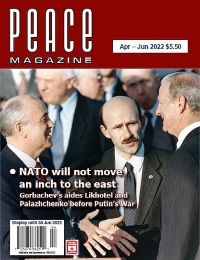
Peace Magazine April-June 2022, page 44. Some rights reserved.
Search for other articles by Peggy Mason here
Hiding in Plain Sight: Uncovering Nuclear Histories
Robert Anderson, Editor.
Simon Fraser University, Jan. 2022
In my latest encounter with the National Archives I sought a 1985 report on Canada’s potential participation in Reagan’s Strategic Defence Initiative. This required an in-person appointment to view it. So, I came to this wonderful little book well aware of the challenges in accessing even non-sensitive, much less nuclear-related, records. I came away with a richer understanding of archival research in “recapturing the past” and the challenge of making sense of non-traditional sources in digital archives.
This is a collection of essays about nuclear archival studies. From such a curiously neglected area of research, the book presents wildly diverse encounters of researchers in Canada, the US, Japan, Ukraine and India in archives with rules about “official secrets and sensitive evidence.” In one poignant note we learn that Greg Donaghy, diplomatic historian and head of the Historical Section of Global Affairs Canada, had intended show the nuclear question as “one of the central preoccupations of postwar Canadian diplomacy,” but he died before being able to undertake this work.
Former diplomat Paul Meyer reveals the loss of vital records and even archival capacity at Global Affairs Canada in the transfer over to electronic filing. Another chapter discusses the 1962-63 Bomarc missile crisis. Closed archives had led historians to rely on available memoirs and recollections that provided an incomplete picture of the “near breach” in Canadian-American relations when Prime Minister John Diefenbaker refused to equip the missiles with nuclear warheads.
Nancy Teeple’s chapter shows the importance of archives in providing the context for the examination of government policy on nuclear issues, including the interplay of actors. John O’Brien discusses the use of photography for the recording of nuclear episodes. Indeed, each chapter ends with an archival photo of a singular piece of nuclear history. Claude-Yves Charron examines archives established after Fukushima’s Daiichi nuclear accident. These have been compiled in one fully accessible collection—the virtual Cadillac of archives. Chapter 9 demonstrates the dearth of records in both Canada and Japan on the social impacts of the nuclear industry and notes the generally negative impact on remote, indigenous communities.
Drawing on the public health controversy surrounding radiation contamination in Port Hope, Marissa Bell considers what information ought to be valued in the archival format and suggests the inclusion of community histories. Likewise, Sarah Fox discusses “radiogenic community archives”—the oral narratives of ordinary, often indigenous, people who have been affected by radioactive exposure.
Lindsay Freeman analyzes the connection of Oak Ridge (the Atomic City) with “the Bomb.” The contamination of First Nations fishing grounds and sacred areas in Elliot Lake, Ontario is Linda Richards’ case study of “agnotology”, culturally induced ignorance, particularly the publication of inaccurate or misleading scientific data in relation to the IAEA and the WHO.
Svitlana Matviyenko’s “The Subject of Territory: The Body-Archive after Chernobyl” is haunting. She focuses on transgenerational heritable changes in gene activity (epigenic transformation) due to radiation exposure. She “reads” the bodies of the humans and non-humans physically impacted by this disaster as a “collective body-archive” for such epigenic transformation. Since my first reading of the chapter about Chernobyl, Russia has invaded Ukraine and the decommissioned Chernobyl plant has experienced fighting and a fire.
Chapter 15 highlights the deleterious effects of uranium mining on indigenous workers and the wall of secrecy in India’s military and civilian programme.
M. V. Ramana also recounts his own efforts to calculate India’s plutonium production in an essay titled “The Inaccessible Archive.”
The final chapter, by Robert Anderson, recounts a consequential event in Canadian nuclear history—the underground Indian nuclear test in May 1974 using a CANDU reactor. It ended nuclear cooperation between our two countries for thirty years. I thought I knew the story rather well from briefings on the subject in the 1990 NPT Review Conference, but this chapter was a surprise. The archival records of this explosion were minimal, but comparative studies across many archives now provide a more complete understanding.
Reviewed by Peggy Mason, formerly Canada’s Ambassador for Disarmament, now president of the Rideau Institute in Ottawa.

Peace Magazine April-June 2022, page 44. Some rights reserved.
Search for other articles by Peggy Mason here